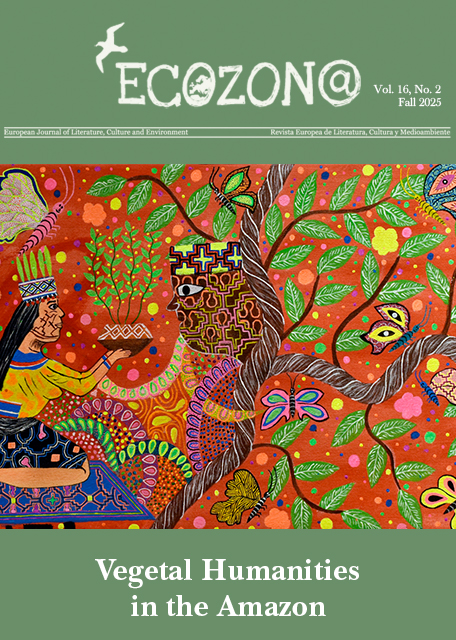<b>Great Apes in Feminine</b> // Grandes simios en femenino
DOI:
https://doi.org/10.37536/ECOZONA.2016.7.1.990Abstract
While Transnational Temps were working on the Simiomobile project and also on the Safari Urbis which focuses on the visual presence of natural species in an urban environment, I noticed the minority presence (or total absence) of females in representations of the species. It is simple, if we look for "gorilla" with any search engine, we find an immense number of male specimens: the females, or rather the image of the female does not have the same presence. I couldn't help but see a parallel relationship with the "absence" or omission of women in the history of humanity. This simplification which cancels out the feminine image of a whole species is not inoffensive. It is similar to other situations referred to as discriminatory, speciesist, xenophobic and racist, the "group name", or mass name (in the meaning attributed to it by Negri and Hardt). To talk about blacks, chinese or women gives rise to a generalised discrimination. This is related, without a doubt, to the fact that the members of these groups are "faceless", they are all grouped with a global standard which identifies them. This form of allusion is what we normally use with animals, gorillas, elephants with a given number of repetitions or copies of the same pattern. In the case of the gorillas it is even more significant; all the gorillas which live in captivity are given a name and reference number for identification purposes (it was only after the studies of Jane Goodall on chimpanzees that the practise of giving a name to these and other primates began).
It has been demonstrated in a great number of species that the individual specimens which make up that species are unique. Maybe humans will never be able to distinguish between the members of a shoal of dolphins, but this does not mean that they are all the same, or worse that they should be the same. Every living being on the planet is unique, a balance can not be established without the acceptance of this and other basic conditions.The anthropomorphism of the great apes plays a fundamental role in our ability to distinguish one from the other. It is only necessary to pay a little attention to see that each one of the gorillas, bonobos, chimpanzees and orangutans in a zoo are completely different from each other.In the Great Apes in Feminine project I use the portrait as a tool to individualise, emphasising that each member of a species is unique.
After more than a decade of "technological" artistic production I took my pencil up again. I was not interested in making photographic or video portraits. To draw a portrait demands a profound connection between individuals, and this is what guided me. The primatologist Sabater Pi (1922-2009) famous for discovering “Copito de Nieve”, believed that drawing portraits was the best technique for representing primates. I am not sure that it is the best technique, but I believe it is a good one for getting to know them. When I draw I "tune in" to the model, this "being with them" (female gorilla-gorilla) enriches me profoundly on a spiritual level. I feel the creative process as a form of dialogue, a "morphological echo".The portrait is a form of differentiation, of individualisation, it shows the unique nature of the subject; in this way, and from an ecofeminist point of view, I find a complete coherence in this practise of "portraying" female gorillas, making their unique and unrepeatable nature evident. Drawing allows me to work in a more detailed way on certain aspects and simply sketch others. I try in this way to bring out the physiological characteristics which stand out in each of the females I draw and which make up the "feminine" image of gorillas found in spanish zoos. “Planet Earth –or Gaia– is not human, nor does it belong to humans. Humans are not the center of life; we are a recent, rapidly growing part of an enormous ancient whole. Gaia is the place for all the living beings we know. It is also the place where our dreams are born. If we feel our lives to be something more than a succession of hedonistic distractions then it is crucial that we reconnect with the biosphere.” (Perales, 2016 :352)
Resumen
Mientras que, como Transnational Temps, desarrollaba Simiomobile y también de Safari Urbis, que focalizan sobre la confluencia de la extinción de los Gorilas de montaña y sobre la presencia “visual” de especies naturales en nuestro entorno urbano, me percaté de la presencia minoritaria o total ausencia de hembras en la representación de especies. Es simple, si buscamos el término “Gorilla” en cualquier navegador, encontramos un número descompensado de imágenes de machos; las hembras, o mejor dicho: la imagen de las hembras, no tiene el mismo peso. No pude evitar establecer una relación de paralelismo con la “ausencia” u omisión de la mujer en la Historia de la Humanidad. Esta reduccio?n, que anula la imagen de la entera mitad de una especie no es anodina. Cai? en la cuenta de otra cuestio?n que se refiere al comportamiento discriminatorio, especista, xeno?fobo y racista, se trata del “nombre grupal”, el nombre de la masa, en el sentido que Negri y Hardt dan a este te?rmino. Hablar de negros, o chinos o mujeres, propicia la discriminacio?n generalizada. Esto esta? relacionado, sin lugar a dudas, con el hecho de que estos grupos no tengan “caras” plurales, todos se situ?an bajo un patro?n global que los clasifica a modo de identidad homogénea. Esta forma de alusio?n es la que utilizamos normalmente con los animales, los gorilas, o los elefantes, como un nu?mero dado de repeticiones o copias del mismo patro?n. En el caso de los gorilas es au?n ma?s significativo; todos los ejemplares de gorila que se encuentran en cautiverio reciben un nombre y tienen un nu?mero de referencia, un nu?mero de identidad (fue a partir de los estudios de Jane Goodall sobre los chimpance?s que se empieza a asignar un nombre a estos y otros primates). Se ha demostrado no obstante en un gran nu?mero de especies, la condicio?n u?nica de cada uno de los individuos que la componen.Tal vez el hombre nunca llegue a ser capaz de distinguir las diferencias entre los componentes de una manada de delfines, pero esto no quiere decir que todos ellos sean iguales, o peor, que todos sean el mismo. Cada ser vivo es u?nico en este planeta, el equilibrio sostenible no surgira? sin la aceptacio?n de esta y otras bases.
El antropomorfismo de los Grandes Simios juega un papel fundamental en nuestra relativa facilidad para distinguir unos de otros. So?lo es necesario prestar un poco de atencio?n para ver que cada uno de los gorilas, bonobos, chimpance?s u orangutanes de un parque zoolo?gico se diferencian de forma neta. Despue?s de ma?s de una de?cada de produccio?n arti?stica alejada de las técnicas tradicionales, retome? los la?pices. No me interesaba hacer retratos fotogra?ficos, ni tampoco retratos de vi?deo. Retratar a trave?s del dibujo exige una conexio?n profunda del individuo, y esto es lo que me guiaba. El primato?logo Sabater Pi (1922- 2009), famoso por descubrir a Copito de Nieve, sosteni?a que el dibujo era la mejor te?cnica para captar a los primates. Yo no estoy segura de que sea la mejor te?cnica para representarlos, pero si? creo que es una buena te?cnica para conocerlos. Cuando dibujo “sintonizo” con el modelo, este “ser-con ellas” (hembra gorilla-gorilla) me enriquece profundamente a nivel espiritual. Siento el proceso creativo como una forma de dia?logo, a modo de “resonancia mo?rfica”.
El retrato es una forma de diferenciacio?n, de individuacio?n, subraya la unicidad de lo representado; en este sentido, y desde la perspectiva ecofeminista, encuentro una plena coherencia en este “retratar” a las hembras gorila, afirmo su cara?cter u?nico e irrepetible. El dibujo me permite trabajar con ma?s detalle ciertos detalles y simplemente esbozar otros, procuro de esta manera destacar las caracteri?sticas fisiolo?gicas que destacan en cada una de las hembras retratadas y que componen la imagen “femenina” plural de las gorilas que se encuentran en los zoos espan?oles. “El planeta Tierra –o Gaia– no es humano, ni pertenece a los humanos. Los humanos no somos el centro de la vida, tan sólo somos unos recién llegados creciendo rápidamente como parte de un todo, un todo muchísimo más antiguo. Gaia es el hogar de todos los seres vivos que conocemos. Y también es la cuna de nuestros sueños. Si consideramos que nuestras vidas son, en suma, algo más que una sucesión de distracciones hedonísticas, entonces debemos re-conectar con la biosfera.” (Perales, 2016 :352).
Downloads
Downloads
Published
Issue
Section
License
Authors who publish with this journal agree to the following terms:
a) Authors retain copyright and grant the journal right of first publication with the work simultaneously licensed under a Creative Commons Attribution License that allows others to share the work with an acknowledgement of the work's authorship and initial publication in this journal (CC BY-NC for articles and CC BY-NC-ND for creative work, unless author requests otherwise.
b) Authors are able to enter into separate, additional contractual arrangements for the non-exclusive distribution of the journal's published version of the work (e.g., post it to an institutional repository or publish it in a book), with an acknowledgement of its initial publication in this journal.
c) Authors are permitted and encouraged to post their work online (e.g., in institutional repositories or on their website) prior to and during the submission process, as it can lead to productive exchanges, as well as earlier and greater citation of published work (See The Effect of Open Access).










